Anti-fascism
| Part of a series on |
| Fascism |
|---|
 |
|
Organizations |
|
Lists |
|
Variants
|
|
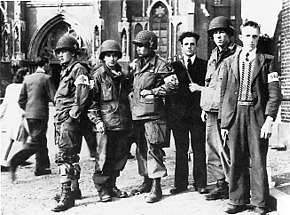
Anti-fascism is opposition to fascist ideologies, groups and individuals. The anti-fascist movement began in a few European countries in the 1920s, and eventually spread to other countries around the world. It was as its most significant shortly before and during World War II, where the fascist Axis powers were opposed by many countries forming the Allies of World War II and dozens of resistance movements worldwide. Anti-fascism has been an element of movements holding many different political positions, including social democratic, nationalist, liberal, conservative, communist, Marxist, capitalist, anarchist, socialist, and centrist viewpoints.
Origins
With the development and spread of Italian Fascism, i.e. original fascism, the National Fascist Party's ideology was met with increasingly militant opposition by Italian communists and socialists. Organizations such as the Arditi del Popolo[1] and the Italian Anarchist Union[2] emerged between 1919–1921, to combat the nationalist and fascist surge of the post-World War I period.
In the words of historian Eric Hobsbawm, as fascism developed and spread, a "nationalism of the left" developed in those nations threatened by Italian irredentism (e.g. in the Balkans, and Albania in particular).[3] After the outbreak of World War II, the Albanian and Serbian resistances were instrumental in antifascist action and underground resistance. This combination of irreconcilable nationalisms and leftist partisans constitute the earliest roots of European anti-fascism. Less militant forms of anti-fascism arose later. For instance, during the 1930s in Britain, "Christians – especially the Church of England – provided both a language of opposition to fascism and inspired anti-fascist action".[4]
The diversity of political entities that share only their anti-fascism has prompted the historian Norman Davies to argue in his book Europe at War 1939–1945: No Simple Victory that anti-fascism does not offer a coherent political ideology, but rather that it is an "empty vessel". Davies further asserts that the concept of anti-fascism is a "mere political dance" created by Josef Stalin and spread by Soviet propaganda organs in an attempt to create the false impression that Western democrats by joining the USSR in the opposition to fascism could in general align themselves politically with communism. The motive would be to lend legitimacy to the dictatorship of the proletariat and was done at the time the USSR was pursuing a policy of collective security. Davies goes on to point out that with Winston Churchill as a notable exception, the concept of anti-fascism gained widespread support in the West, except that its credibility suffered a serious but temporary blow while the USSR and Nazi Germany coordinated their wars of aggression in Eastern Europe under their Molotov–Ribbentrop Pact.[5]
History
Anti-fascist movements emerged first in Italy, during the rise of Mussolini, but soon spread to other European countries and then globally. In the early period, Communist, socialist, anarchist and Christian workers and intellectuals were involved. Until 1928, the period of the United front, there was significant collaboration between the Communists and non-Communist anti-fascists. In 1928, the Comintern instituted its ultra-left "Third Period" policies, ending co-operation with other left groups, and denouncing social democrats as "social fascists". From 1934 until the Molotov–Ribbentrop Pact, the Communists pursued a Popular Front approach, of building broad-based coalitions with liberal and even conservative anti-fascists. As fascism consolidated its power, and especially during World War II, anti-fascism largely took the form of Partisan or Resistance movements.
Italy: against Fascism and Mussolini
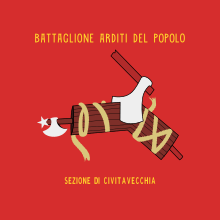
In Italy, Benito Mussolini's Fascist regime used the term "anti-fascist" to describe its opponents. Mussolini's secret police was officially known as Organizzazione per la Vigilanza e la Repressione dell'Antifascismo (OVRA), Italian for "Organization for Vigilance and Repression of Anti-Fascism").
In the Kingdom of Italy in the 1920s, anti-fascists—many from the labour movement—fought against the violent Blackshirts and against the rise of fascist leader Benito Mussolini. After the Italian Socialist Party (PSI) signed a pacification pact with Mussolini and his Fascist Revolutionary Party (PFR) on 3 August 1921,[6] and trade unions adopted a legalist and pacified strategy, members of the workers' movement who disagreed with this strategy formed the Arditi del popolo. The General Confederation of Labour (CGT) and the PSI refused to officially recognize the anti-fascist militia, while the Italian Communist Party (PCI) ordered its members to quit the organization. The PCI organized some militant groups, but their actions were relatively minor, and the party maintained a non-violent, legalist strategy. The Italian anarchist Severino Di Giovanni, who exiled himself to Argentina following the 1922 March on Rome, organized several bombings against the Italian fascist community.[7]
Italian liberal anti-fascist Benedetto Croce wrote Manifesto of the Anti-Fascist Intellectuals, which was published in 1925.[8] Another notable Italian liberal anti-fascist around that time was Piero Gobetti.[9]
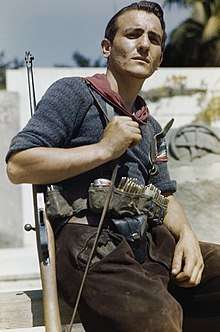
Between 1920 and 1943, several anti-fascist movements were active among the Slovenes and Croats in the territories annexed to Italy after World War I, known as the Julian March.[10][11] The most influential was the militant insurgent organization TIGR, which carried out numerous sabotages, as well as attacks on representatives of the Fascist Party and the military.[12][13] Most of the underground structure of the organization was discovered and dismantled by the Organization for Vigilance and Repression of Anti-Fascism (OVRA) in 1940 and 1941,[14] and after June 1941, most of its former activists joined the Slovene Partisans.
During World War II, many members of the Italian resistance left their homes and went to live in the mountainside, fighting against Italian fascists and German Nazi soldiers. Many cities in Italy, including Turin, Naples and Milan, were freed by anti-fascist uprisings.[15]
Slovenians under Italianisation
The anti-fascist resistance emerged within the Slovene minority in Italy (1920–1947), who the Fascists meant to deprive of their culture, language and ethnicity. The 1920 burning of the National Hall in Trieste, the Slovene center in the multi-cultural and multi-ethnic Trieste by the Blackshirts,[16] Benito Mussolini who, at the time, was yet to become Duce, praised as a being a "masterpiece of the Triestine fascism" (capolavoro del fascismo triestino...).[17] Not only in multi-ethnic areas, but also in the areas where the population was exclusively Slovene, the use of Slovene language in public places, including churches, was forbidden.[18] Children, if they spoke Slovene, were punished by Italian teachers who were brought by the Fascist State from Southern Italy. The Slovene teachers, writers, and clergy were sent to the other side of Italy.
The first anti-fascist organization, called TIGR, was formed by Slovenes and Croats in 1927 in order to fight Fascist violence. Its guerrilla fight continued into the late 1920s and 1930s when by the mid-1930s, already 70,000 Slovenes fled Italy mostly to Slovenia (then part of Yugoslavia) and South America.
The Slovene anti-fascist resistance in Yugoslavia during World War II was led by Liberation Front of the Slovenian People. The Province of Ljubljana, occupied by Italian Fascists, saw the deportation of 25.000 people, equaling 7.5% of the total population, filling up Rab concentration camp and Gonars concentration camp and other Italian concentration camps.
Germany: against the NSDAP and Hitlerism
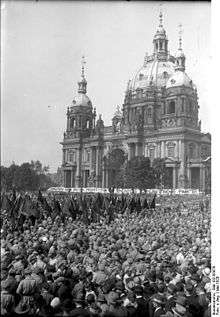
In the 1920s and 1930s in the Weimar Republic, Communist Party and Social Democratic Party members advocated violence and mass agitation amongst the working class to first stop the Freikorps movements in immediate post-WW I Germany, and not long thereafter, Adolf Hitler's Nazi Party. Soviet revolutionary Leon Trotsky wrote:
[F]ighting squads must be created ... nothing increases the insolence of the fascists so much as 'flabby pacifism' on the part of the workers' organisations ... [It is] political cowardice [to deny that] without organised combat detachments, the most heroic masses will be smashed bit by bit by fascist gangs."[19]
There were several anti-Nazi militant and paramilitary groups. These included the Social Democrat-dominated Reichsbanner Schwarz-Rot-Gold (formed in February 1924), the Communist paramilitary and propaganda organisation Roter Frontkämpferbund (Red Front Fighters League or RFB, formed in summer 1924) and the Communist Kampfbund gegen den Faschismus (Fighting-Alliance against Fascism, formed in 1930).[20] The Roter Front was a paramilitary organization affiliated with the Communist Party of Germany that engaged in street fights with the Nazi Sturmabteilung. Its first leader was Ernst Thälmann, who would later die in a concentration camp and become widely honored in East Germany as an anti-fascist and socialist. In 1932, during the United Front period, Antifaschistische Aktion was formed as a broad-based alliance in which Social Democrats, Communists and others could fight legal repression and engage in self-defence against Nazi paramilitaries.[21] Its two-flag logo, designed by Max Keilson and Max Gebhard, is still widely used as a symbol of militant anti-fascists globally.[22]
Spain: Civil War with the Nationalists
In Spain, large-scale anti-fascist movements were first seen in the 1930s, before and during the Spanish Civil War. The republican government and army, the Antifascist Worker and Peasant Militias (MAOC) linked to the Communist Party (PCE),[23] the International Brigades, the Workers' Party of Marxist Unification (POUM), Spanish anarchist militias, such as the Iron Column and the autonomous governments of Catalonia and the Basque Country, fought the rise of Francisco Franco with military force. The Friends of Durruti, associated with the Federación Anarquista Ibérica (FAI), were a particularly militant group. Thousands of people from many countries went to Spain in support of the anti-fascist cause, joining units such as the Abraham Lincoln Brigade, the British Battalion, the Dabrowski Battalion, the Mackenzie-Papineau Battalion, the Naftali Botwin Company and the Thälmann Battalion, including Winston Churchill's nephew, Esmond Romilly.[24] Notable anti-fascists who worked internationally against Franco included: George Orwell (who fought in the POUM militia and wrote Homage to Catalonia about this experience), Ernest Hemingway (a supporter of the International Brigades who wrote For Whom the Bell Tolls about this experience), and radical journalist Martha Gellhorn.
Spanish anarchist guerrilla Francesc Sabaté Llopart fought against Franco's regime until the 1960s, from a base in France. The Spanish Maquis, linked to the PCE, also fought the Franco regime long after the Spanish Civil war had ended.[25]
France: against Action Française and Vichy

In the 1920s and 1930s in the French Third Republic, anti-fascists confronted aggressive far-right groups such as the Action Française movement in France, which dominated the Latin Quarter students' neighborhood. After fascism triumphed via invasion, the French Resistance (French: La Résistance française) or, more accurately, resistance movements fought against the Nazi German occupation and against the collaborationist Vichy régime. Résistance cells were small groups of armed men and women (called the maquis in rural areas), who, in addition to their guerrilla warfare activities, were also publishers of underground newspapers and magazines such as Arbeiter und Soldat (Worker and Soldier) during World War 2, providers of first-hand intelligence information, and maintainers of escape networks.
United Kingdom: against Mosley's BUF
The rise of Oswald Mosley's British Union of Fascists (BUF) in the 1930s was challenged by the Communist Party of Great Britain, socialists in the Labour Party and Independent Labour Party, anarchists, Irish Catholic dockmen and working class Jews in London's east end. A high point in the struggle was the Battle of Cable Street, when thousands of eastenders and others turned out to stop the BUF from marching. Initially, the national Communist Party leadership wanted a mass demonstration at Hyde Park in solidarity with Republican Spain, instead of a mobilisation against the BUF, but local party activists argued against this. Activists rallied support with the slogan They shall not pass, adopted from Republican Spain.
There were debates within the anti-fascist movement over tactics. While many east end ex-servicemen participated in violence against fascists,[26] Communist Party leader Phil Piratin denounced these tactics and instead called for large demonstrations.[27] In addition to the militant anti-fascist movement, there was a smaller current of liberal anti-fascism in Britain; Sir Ernest Barker, for example, was a notable English liberal anti-fascist in the 1930s.[28]
United States, circa World War II
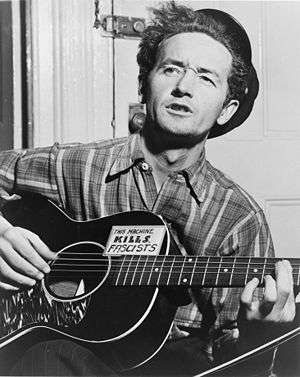
There were fascist elements in the United States in the 1930s such as Friends of New Germany, the German American Bund, the Ku Klux Klan, and Charles Coughlin.[29]
During the United States Red Scare after the end of World War II, the term "premature anti-fascist" came into currency to describe Americans who had strongly agitated or worked against fascism, such as by fighting for the Republicans in the Spanish Civil War, before fascism was seen as a proximate and existential threat to the United States (which only occurred generally after the invasion of Poland by Nazi Germany and universally after the attack on Pearl Harbor). The implication was that such persons were Communists or Communist sympathizers whose loyalty to the United States was suspect.[30][31][32] However, historians John Earl Haynes and Harvey Klehr have written that no documentary evidence has been found of the US government referring to American members of the International Brigades as "premature antifascists"; the Federal Bureau of Investigation, Office of Strategic Services, and United States Army records used terms such as "Communist", "Red", "subversive", and "radical" instead. Haynes and Klehr indicate that they have instead found many examples of members of the XV International Brigade and their supporters referring to themselves sardonically as "premature antifascists".[33]
After World War II
The anti-fascist movements which emerged during the period of classical fascism, both liberal and militant, continued after the defeat of the Axis powers in response to the resilience and mutation of fascism in Europe and elsewhere. In Germany, for example, in 1944, as Nazi rule crumbled, veterans of the 1930s anti-fascist struggles formed "Antifaschistische Ausschüsse," "Antifaschistische Kommittees" or "Antifaschistische Aktion" groups (all typically abbreviated to Antifa).[34]
United Kingdom: against the NF and BNP
After World War II, Jewish war veterans in the 43 Group continued the tradition of militant confrontations with Oswald Mosley's Union Movement. In the 1960s, the 62 Group continued the struggle against neo-Nazis.[35]
In the 1970s, fascist and far-right parties such as the National Front (NF) and British Movement (BM) were making significant gains electorally, and were increasingly bold in their public appearances. This was challenged in 1977 with the Battle of Lewisham, when thousands of people disrupted an NF march in South London.[36] Soon after, the Anti-Nazi League (ANL) was launched by the Socialist Workers Party (SWP). The ANL had a large-scale propaganda campaign and squads that attacked NF meetings and paper sales. The success of the ANL's campaigns contributed to the end of the NF's period of growth. During this period, there were also a number of black-led anti-fascist organisations, including the Campaign Against Racism and Fascism (CARF) and local groups like the Newham Monitoring Project.[37]
The SWP disbanded the ANL in 1981, but many squad members refused to stop their activities. They were expelled from the SWP in 1981, many going on to found Red Action. The SWP used the term squadism to dismiss these militant anti-fascists as thugs. In 1985, some members of Red Action and the anarcho-syndicalist Direct Action Movement launched Anti-Fascist Action (AFA). Their founding document said "we are not fighting Fascism to maintain the status quo but to defend the interests of the working class".[38][39] Thousands of people took part in AFA mobilisations, such as Remembrance Day demonstrations in 1986 and 1987, the Unity Carnival, the Battle of Cable Street's 55th anniversary march in 1991, and the Battle of Waterloo against Blood and Honour in 1992.[40] After 1995, some AFA mobilisations still occurred, such as against the NF in Dover in 1997 and 1998. However, AFA wound down its national organisation and some of its branches and had ceased to exist nationally by 2001.[41]
There was a surge in fascist activity across Europe from 1989 to 1991 after the collapse of Communism. In 1991, the Campaign Against Fascism in Europe (CAFE) coordinated a large militant protest against the visit to London by French right-wing leader, Jean-Marie Le Pen. This sparked a surge in anti-fascist organisations throughout Europe. In the UK alone, in 1992 a number of left-wing groups formed anti-fascist front organisations, such as a re-launched ANL in 1992, the Socialist Party's Youth against Racism in Europe YRE, and the Revolutionary Communist Party's Workers Against Racism. A number of black-led organisations, along with the Labour Party Black Sections and the National Black Caucus, formed the Anti-Racist Alliance in 1991, which eventually became the National Assembly Against Racism.[42]
In August 2018, the Shadow Chancellor John McDonnell called for a revival of "an Anti-Nazi League-type cultural and political campaign" following a number of far-right and racist incidents in the UK, including fascist attacks on a socialist bookshop by members of the far-right and UKIP, marches in favour of far-right activist Tommy Robinson and high-profile Islamophobia in the Conservative Party.[43][44] This "welcome and timely" call to action was supported in a Guardian letter signed by the league's founders, which included former Labour minister Peter Hain, political activist Paul Holborow and leading musicians from Rock Against Racism.[44]
See also
- Anti-authoritarianism
- Anti-capitalism
- Anti-communism
- Anti-Germans (political current)
- Antifa movements
- Anti-Fascist Bloc
- Antifascist Front of Slavs in Hungary
- Anti-racism
- Antifascist Circle
- Anti-Stalinist left
- Denazification
- Italian resistance movement
- Laws against Holocaust denial
- Resistance during World War II
- Resistance movement
- Redskin (subculture)
- Slovak National Uprising
- Squadism
- Yugoslav Partisans
Notes
- ↑ Gli Arditi del Popolo (Birth) Archived 7 August 2008 at the Wayback Machine. (in Italian)
- ↑ "Unione Anarchica Italiana" at italian anarchopedia
- ↑ Hobsbawm, Eric (1992). The Age of Extremes. Vintage. pp. 136–37. ISBN 0394585755.
- ↑ Lawson, Tom (2010). Varieties of Anti-Fascism: Britain in the Inter-War Period. Palgrave Macmillan UK. pp. 119–39. ISBN 978-1-349-28231-9.
- ↑ Davies, Norman (2006). Europe at War 1939–1945: No Simple Victory. London: Macmillan. pp. 54–55. ISBN 9780333692851. OCLC 70401618.
- ↑ Charles F. Delzell, edit., Mediterranean Fascism 1919-1945, New York, NY, Walker and Company, 1971, p. 26
- ↑ "Anarchist Century". Anarchist_century.tripod.com. Retrieved 7 April 2014.
- ↑ David Ward Antifascisms: Cultural Politics in Italy, 1943–1946
- ↑ James Martin, 'Piero Gobetti's Agonistic Liberalism', History of European Ideas, 32, (2006), pp. 205–222.
- ↑ Milica Kacin Wohinz, Jože Pirjevec, Storia degli sloveni in Italia : 1866–1998 (Venice: Marsilio, 1998)
- ↑ Milica Kacin Wohinz, Narodnoobrambno gibanje primorskih Slovencev : 1921–1928 (Trieste: Založništvo tržaškega tiska, 1977)
- ↑ Milica Kacin Wohinz, Prvi antifašizem v Evropi (Koper: Lipa, 1990)
- ↑ Mira Cenčič, TIGR : Slovenci pod Italijo in TIGR na okopih v boju za narodni obstoj (Ljubljana: Mladinska knjiga, 1997)
- ↑ Vid Vremec, Pinko Tomažič in drugi tržaški proces 1941 (Trieste: Založništvo tržaškega tiska, 1989)
- ↑ "Intelligence and Operational Support for the Anti-Nazi Resistance". Darbysrangers.tripod.com.
- ↑ "90 let od požiga Narodnega doma v Trstu" [90 Years From the Arson of the National Hall in Trieste]. Primorski dnevnik [The Littoral Daily] (in Slovenian). 2010. pp. 14–15.
COBISS 11683661. Retrieved 28 February 2012.
Požig Narodnega doma ali šentjernejska noč tržaških Slovencev in Slovanov [Arson of the National Hall or the St. Bartholomew's Night of the Triestine Slovenes and Slavs]
- ↑ Sestani, Armando, ed. (10 February 2012). "Il confine orientale: una terra, molti esodi" [The Eastern Border: One Land, Multiple Exoduses]. I profugi istriani, dalmati e fiumani a Lucca [The Istrian, Dalmatian and Rijeka Refugees in Lucca] (PDF) (in Italian). Instituto storico della Resistenca e dell'Età Contemporanea in Provincia di Lucca. pp. 12–13.
- ↑ Hehn, Paul N. (2005). A low dishonest decade: the great powers, Eastern Europe, and the economic origins of World War II, 1930–1941. Continuum International Publishing Group. pp. 44–45. ISBN 0-8264-1761-2.
- ↑ quoted Fighting Talk no.22 October 1999, p. 11
- ↑ Eve Rosenhaft, Beating the Fascists?: The German Communists and Political Violence 1929-1933, Cambridge University Press, 25 Aug 1983, pp.3-4
- ↑ Eve Rosenhaft, Beating the Fascists?: The German Communists and Political Violence 1929-1933, Cambridge University Press, 25 Aug 1983, p.81
- ↑ Loren Balhorn The Lost History of Antifa" Jacobin May 2017
- ↑ De Miguel, Jesús y Sánchez, Antonio: Batalla de Madrid, in his Historia Ilustrada de la Guerra Civil Española. Alcobendas, Editorial LIBSA, 2006, pp. 189–221.
- ↑ Boadilla by Esmond Romilly. The Clapton Press Limited, London. 2018. ISBN 978-1999654306
- ↑ See "Wolf Moon" by Julio Llamazares, Peter Owen Publications, London 2017 ISBN 978-0720619454
- ↑ Jacobs, Joe (1991) [1977]. Out of the Ghetto. London: Phoenix Press.
- ↑ Phil Piratin Our Flag Stays Red. London: Lawrence & Wishart, 2006.
- ↑ Andrezj Olechnowicz, 'Liberal anti-fascism in the 1930s the case of Sir Ernest Barker', Albion 36, 2005, pp. 636–60
- ↑ jsmog (18 December 2004). "Support for Hitler (or Fascism) in the United States". Third World Traveler. Retrieved 29 December 2013.
- ↑ Premature antifascists and the Post-war world, Abraham Lincoln Brigade Archives Bill Susman Lecture Series. King Juan Carlos I of Spain Center at New York University, 1998. Retrieved 9 August 2009.
- ↑ Knox, Bernard (Spring 1999). "Premature Anti-Fascist". Antioch Review. 57 (2): 133–49. JSTOR 4613837.
- ↑ John Nichols (26 October 2009). "Clarence Kailin: 'Premature Antifascist' – and proudly so". Cap Times. Capital Times (Madision, Wisconsin). Retrieved 29 December 2013.
- ↑ Haynes, John Earl; Klehr, Harvey (2005). In Denial: Historians, Communism & Espionage. San Francisco: Encounter Books. p. 123. ISBN 159403088X. Retrieved 22 March 2014.
- ↑ Balhorn, Loren (8 May 2017). "The Lost History of Antifa". Jacobin.
- ↑ Prowe, Diethelm (November 1994). "'Classic' Fascism and the New Radical Right in Western Europe: Comparisons and Contrasts". Contemporary European History. 3 (3): 289–313. JSTOR 20081528.
- ↑ "The real losers in Saturday's battle of Lewisham | 1970–1979". century.guardian.co.uk. Retrieved 7 April 2014.
- ↑ NMP’s History of Resisting Racism and Injustice; Alastair BonnettRadicalism, Anti-Racism and Representation, London: Routledge, 2013, p. 57; Nigel Copsey Anti-Fascism in Britain, Springer, 1999, pp. 125–83
- ↑ "Anti-Fascist Action: Radical resistance or rent-a-mob?" (PDF). Soundings – issue 14 Spring 2000. Amielandmelburn.org.uk.
- ↑ AFA (London) Constitution Part 1.4
- ↑ "Diamond in the Dust – The Ian Stuart Biography". Skrewdriver.net. Retrieved 7 April 2014.
- ↑ Nigel Copsey Anti-Fascism in Britain London: Routledge, 2016
- ↑ Peter Barberis, John McHugh, Mike Tyldesley (26 July 2005) Encyclopedia of British and Irish Political Organizations: Parties, Groups and Movements of the 20th Century. Continuum International Publishing Group. p. 107. ISBN 978-0-8264-5814-8; Stefano Fella, Carlo Ruzza (24 December 2012) Anti-Racist Movements in the EU: Between Europeanisation and National Trajectories. Palgrave Macmillan. ISBN 978-0-230-29090-7, pp. 67–68
- ↑ Sabbagh, Dan (7 August 2018). "John McDonnell: revive Anti-Nazi League to oppose far right". The Guardian. Retrieved 20 August 2018.
- 1 2 Sabbagh, Dan (15 August 2018). "Anti-Nazi League founders call for new national campaign". The Guardian. Retrieved 20 August 2018.
Further reading
| Library resources about Anti-fascism |
- David Berry "‘Fascism or Revolution!’ Anarchism and Antifascism in France, 1933–39" Contemporary European History Volume 8, Issue 1 March 1999, pp. 51–71
- Birchall, Sean (ed.). Beating The Fascists: The Untold Story of Anti-Fascist Action. ISBN 978-1-904491-12-5.
- Brasken, Kasper. "Making Anti-Fascism Transnational: The Origins of Communist and Socialist Articulations of Resistance in Europe, 1923–1924." Contemporary European History 25.4 (2016): 573-596.
- Bray, Mark (2017). Antifa: The Anti-Fascist Handbook. New York: Melville House. ISBN 978-1612197036.
- Bullstreet, K. Bash the Fash: Anti-Fascist Recollections 1984–1993. ISBN 1-873605-87-0.
- Class War/3WayFight/Kate Sharpley Library Interview from Beating Fascism: Anarchist Anti-Fascism in Theory and Practice, anarkismo.net
- Nigel Copsey Anti-Fascism in Britain; Palgrave Macmillan, January 2000 ISBN 978-0-312-22765-4
- Copsey, N. (2011) 'From direct action to community action: The changing dynamics of anti-fascist opposition', in Copsey, N. and Macklin, G. D. (eds) British National Party: Contemporary perspectives. Routledge
- Nigel Copsey & Andrzej Olechnowicz (eds.), Varieties of Anti-fascism. Britain in the Inter-war Period, Palgrave Macmillan
- Gilles Dauvé "Fascism/Antifascism", libcom.org
- David Featherstone "Black Internationalism, Subaltern Cosmopolitanism, and the Spatial Politics of Antifascism" Annals of the Association of American Geographers Volume 103, 2013 - Issue 6, pp. 1406–1420
- Joseph Fronczak "Local People’s Global Politics: A Transnational History of the Hands Off Ethiopia Movement of 1935 Diplomatic History, Volume 39, Issue 2, 1 April 2015, Pages 245–274
- Hugo Garcia, ed, Transnational Anti-Fascism: Agents, Networks, Circulations Contemporary European History Volume 25, Issue 4 November 2016, pp. 563–572
- Key, Anna (ed.). Beating Fascism: Anarchist anti-fascism in theory and practice. ISBN 1-873605-88-9.
- Renton, Dave. Fascism, Anti-fascism and Britain in the 1940s. Springer, 2016.
- Enzo Traverso "Intellectuals and Anti-Fascism: For a Critical Historization" New Politics, vol. 9, no. 4 (new series), whole no. 36, Winter 2004
External links
| Wikimedia Commons has media related to Antifascist resistance. |

